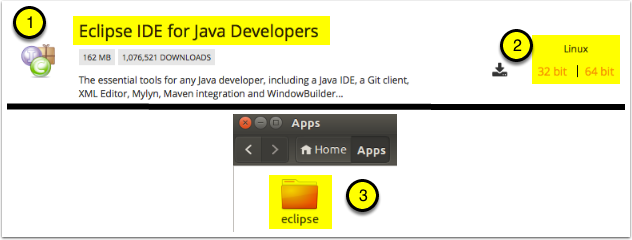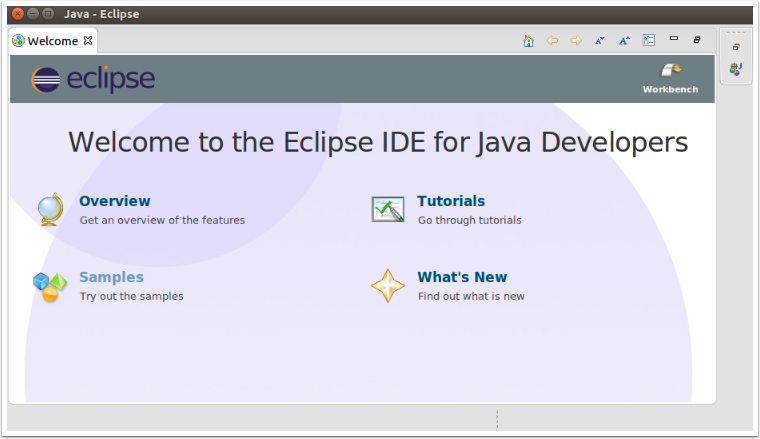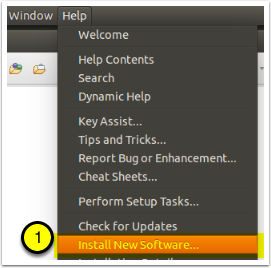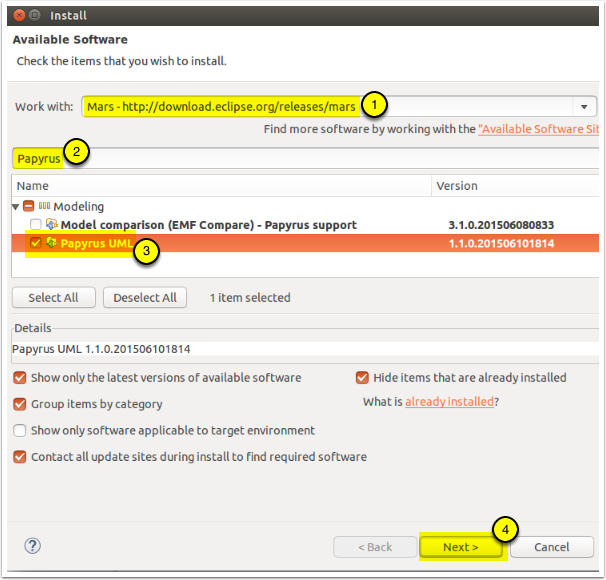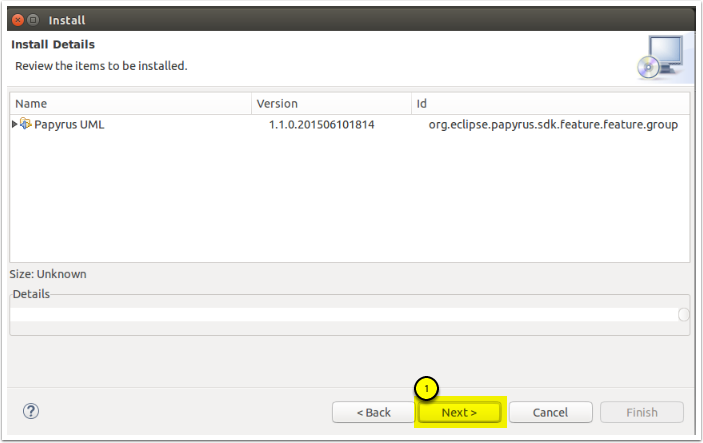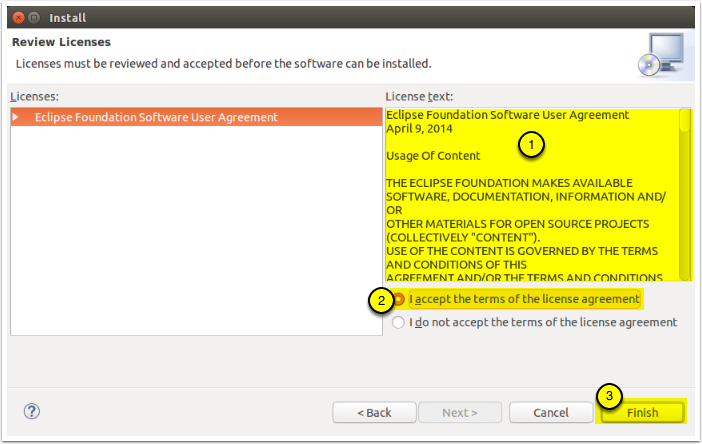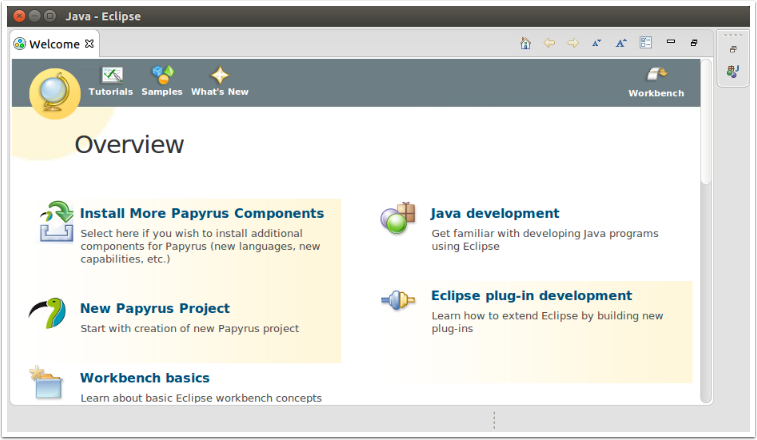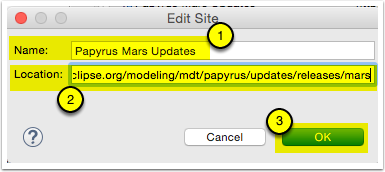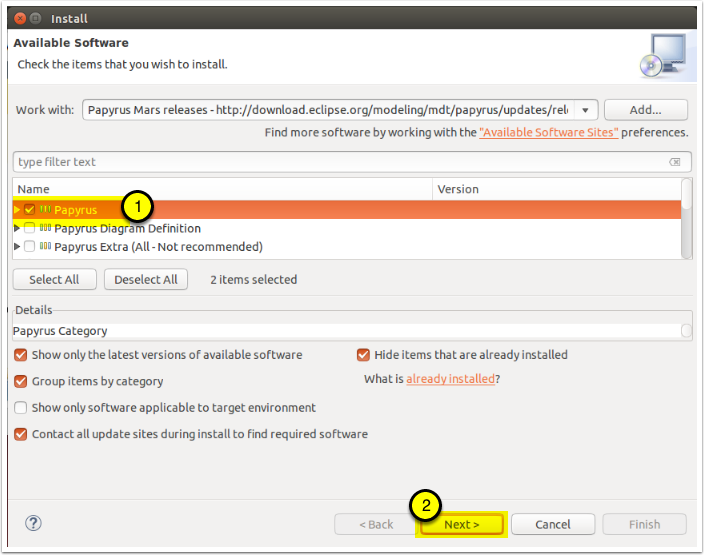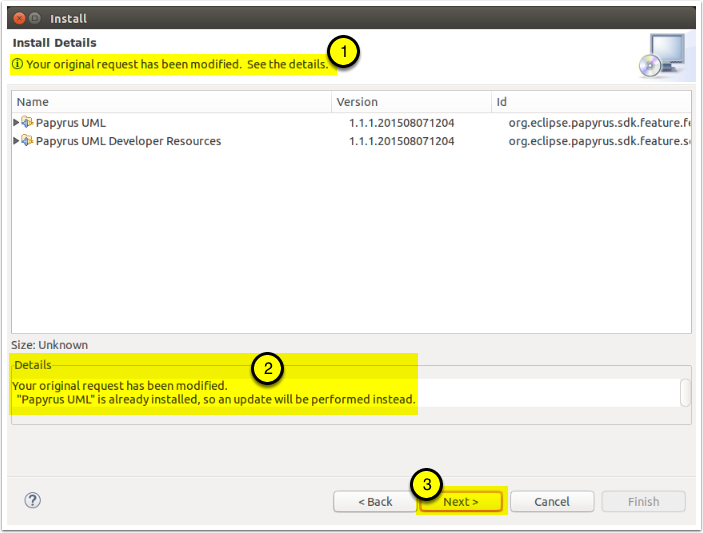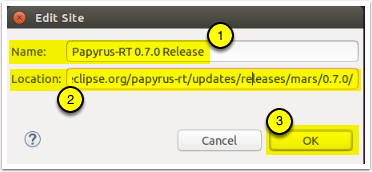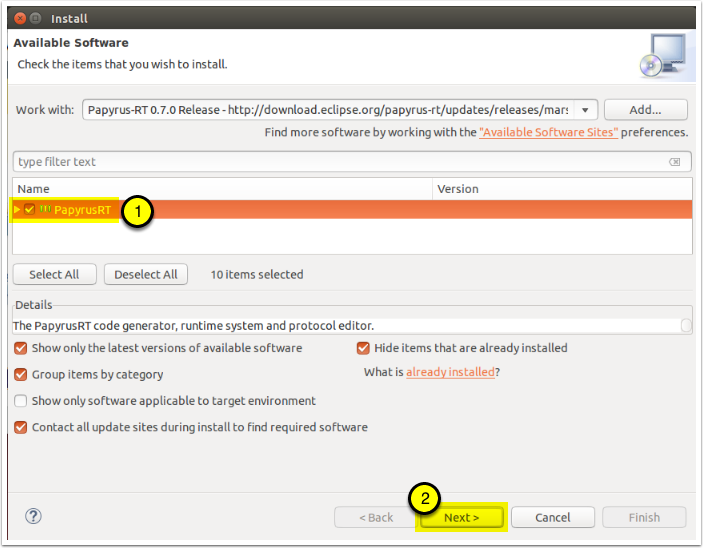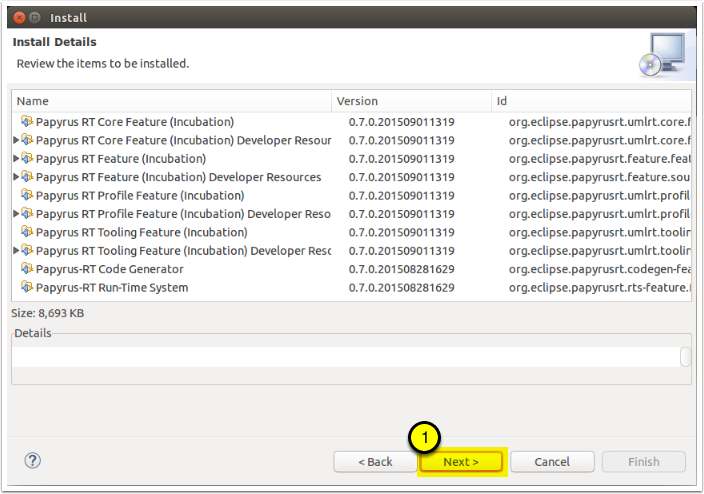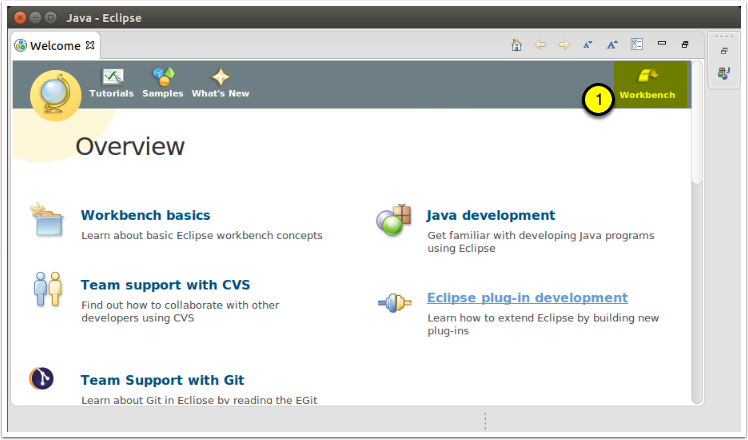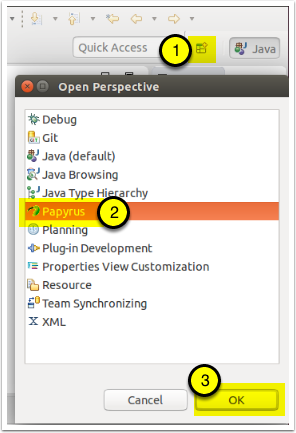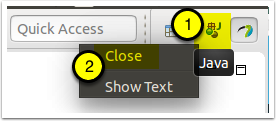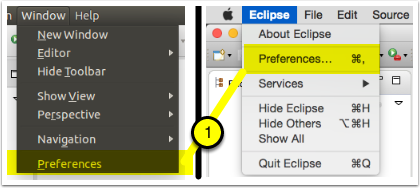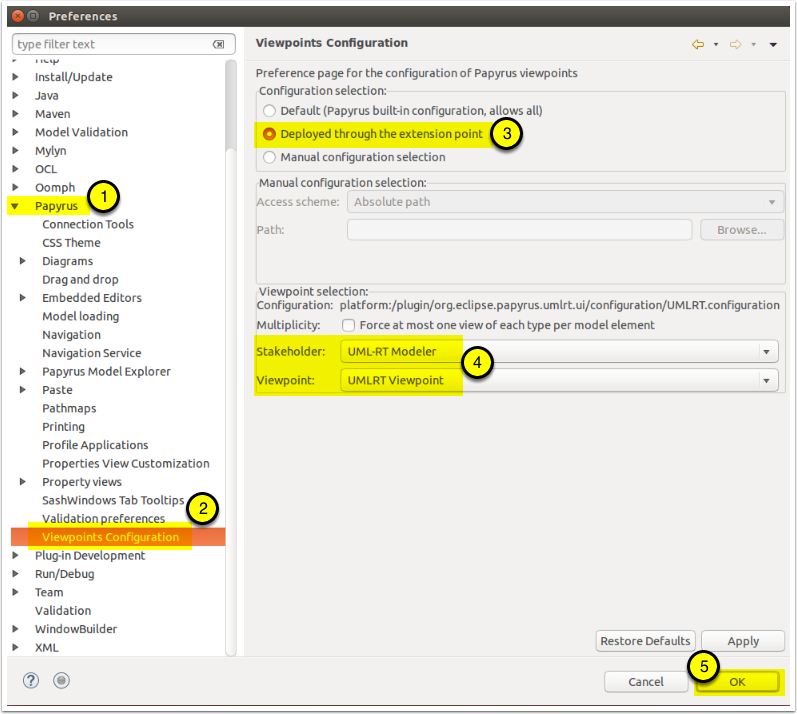Notice: this Wiki will be going read only early in 2024 and edits will no longer be possible. Please see: https://gitlab.eclipse.org/eclipsefdn/helpdesk/-/wikis/Wiki-shutdown-plan for the plan.
Difference between revisions of "Papyrus-RT/User/User Guide/Installation"
(→8. «WORKAROUND» IN CASE OF DUPLICATE MENUS) |
(→8. «WORKAROUND» IN CASE OF DUPLICATE MENUS) |
||
| Line 325: | Line 325: | ||
# Go to the folder where you installed Eclipse, in step 1.1 If you followed the recommendation, that would be "'''cd ~/Apps/Papyrus-RT'''" | # Go to the folder where you installed Eclipse, in step 1.1 If you followed the recommendation, that would be "'''cd ~/Apps/Papyrus-RT'''" | ||
# Change directory to the plugins directory: "'''cd eclipse/plugins'''" | # Change directory to the plugins directory: "'''cd eclipse/plugins'''" | ||
| − | # Remove all the unneccessary plugins: | + | # Remove all the unneccessary plugins: |
| + | #* '''rm -rf org.eclipse.papyrus.umlrt.*''' | ||
| + | #* '''rm -rf org.eclipse.papyrus.umlrt_1.1.*.jar''' | ||
# Start up Eclipse | # Start up Eclipse | ||
| − | The same result can be accomplished using a file browser, being careful | + | The same result can be accomplished using a file browser, being careful to properly select the files to be removed! |
The duplicate menus should now be gone. | The duplicate menus should now be gone. | ||
Revision as of 15:15, 27 August 2015
Contents
- 1 Installing Papyrus for Real Time
- 1.1 1. Install a base Eclipse platform
- 1.2 2. Install Papyrus
- 1.3 3. Update Papyrus
- 1.4 4. Install the Papyrus for Real Time Components
- 1.5 5. Switch to the Papyrus perspective
- 1.6 6. Set the viewpoint for UML-RT
- 1.7 7. Done! You are now ready to create models!
- 1.8 8. «WORKAROUND» IN CASE OF DUPLICATE MENUS
Installing Papyrus for Real Time
This tutorial will show you how to install Papyrus for Real Time.
Note: You will need Java 1.7 installed.
Note: The instructions in this tutorial are illustrated using Linux. Steps and images may differ slightly if the installation is done on a different operating system (both Windows and Mac OS are supported for developing models). Some of these differences have been indicated when known, but some may also be missing.
1. Install a base Eclipse platform
First, we will install a base Eclipse package upon which we will be able to add the required software component for Papyrus for Real Time.
Note: If you are installing into an existing Eclipse workbench, skip this step and go directly to step 2.
1.1 Install a base Eclipse package
- Go to http://eclipse.org/downloads/
- Download the "Eclipse IDE for Java Developers" package for your operating system
- Decompress the downloaded archive to a folder such as "~/Apps/Papyrus-RT" (folder name and location will vary depending on operating system)
Note: The base Eclipse IDE for Java Developers package does not include Papyrus, which is the base for Papyrus for Realtime. We will need to install Papyrus for Real Time after this base package is installed
1.2 Start Eclipse
- Go to the folder where you extracted Eclipse (from the previous step)
- Run "eclipse" (the executable name and representation may vary depending on operating system - Linux shown below)
1.3 Eclipse is now running
The "Welcome" view is the default view after installing Eclipse.
2. Install Papyrus
Now that a base Eclipse environment is installed and available, we will install the remaining components needed for Papyrus for Real Time.
The base for Papyrus for Real Time is, of course, Papyrus UML. Since the base Eclipse IDE for Java Developers package we installed in the previous steps does not include Papyrus, let's install it first.
2.1 Install New Software
- Select the "Help > Install New Software" menu item
2.2 Select to install Papyrus UML
- From the "Work with" field's drop-down menu, select "Mars - http://download.eclipse.org/releases/mars"
- In the "Type filter text" field, type "Papyrus"
- Select "Papyrus UML" from the results
- Click [Next]
2.3 Install Details
After checking all the dependencies, you are presented with a dialog to "Review the items to be installed"
- Click [Next >]
2.4 Review Licenses
You will now need to review and accept the terms of the license agreement before installing.
- Read the terms
- Accept the terms
- Click [Finish]
2.5 Restart the workbench
After all components have been downloaded and installed, you will have to restart the workbench.
- Click on [Yes]
2.6 Papyrus is now installed in the Eclipse workbench
3. Update Papyrus
The version of Papyrus that was just installed is the Mars release version. For Papyrus for Real Time, we need a more recent version, which can be found in a in a separate location.
3.1 Define the location for the new version
Defining a new location is similar to installing new software.
- Select the "Help > Install New Software" menu item
3.2 Add a new site
Because the Papyrus for Real Time is still in incubation and not part of the Mars release train, we will have to add a new location from which components can be installed.
- Click on [Add...]
3.3 Add a new repository
In the resulting dialog, enter the following information:
- Name : Papyrus Mars releases
- Location : http://download.eclipse.org/modeling/mdt/papyrus/updates/releases/mars
- Click [OK]
3.4 Select the software to install
- Select "Papyrus" (and nothing else)
- Click [Next]
3.5 Installation details
The system determines that since Papyrus UML is already installed, an update will be performed instead, which is what we wanted.
- The system informs you that the request to install the new software has been modified and that
- An update will be performed instead
- Click [Next]
3.6 Review the license and accept its terms
3.7 Restart the workbench
After all updated components have been downloaded and installed, you will have to restart the workbench.
- Click on [Yes]
4. Install the Papyrus for Real Time Components
Now that we have a good version of Papyrus, we can install the Papyrus for Real Time components:
- The core and feature components for the user interface
- The profile provides the DSML basics for UML-RT
- The code generator translates the UML-RT model into C++ source code
- The runtime service library provides the framework and infrastructure to be able to execute the code generated from UML-RT models The runtime service library also provides a UML model library of UML-RT constructs that are useful when modeling.
4.1 Install the new software
- Select the "Help > Install New Software" menu item
4.2 Add a new site
Because the Papyrus for Real Time is still in incubation and not part of the Mars release train, we will have to add a new location from which components can be installed.
- Click on [Add...]
4.3 Add a new repository
In the resulting dialog, enter the following information:
- Name : Papyrus-RT 0.7.0 Release
- Location : http://download.eclipse.org/papyrus-rt/updates/releases/mars/0.7.0/
- Click [OK]
4.4 Pick from available software
There is only one component, so the choice is easy
- Select the "PapyrusRT" item
- Click [Next]
4.5 Review the items to install
After checking all the dependencies, you are presented with a dialog to "Review the items to be installed".
- Click [Next]
4.6 Review Licenses
One last time, you will now need to review and accept the terms of the license agreement for the new software before installing.
- Read the terms
- Accept the terms
- Click [Finish]
4.7 Agree to install the software
As this software is still in incubation, some of the components are still unsigned.
- Click [OK]
4.8 Restart the workbench
After all Papyrus for Real Time components have been downloaded and installed, you will have to restart the workbench.
- Click on [Yes]
5. Switch to the Papyrus perspective
We can now switch to the Papyrus perspective in order to start modeling.
5.1 Close the welcome page
- Click on the big arrow, at the top right, to close the welcome view
5.2 Open the Papyrus Perspective
- Click on the "Open Perspective" button, just left of the Java Perspective
- Select the "Papyrus" entry
- Click [OK]
5.3 [Optional] Remove the Java perspective
If you do not need the Java perspective, you can remove it.
- Right click on the Java perspective icon
- Select "Close"
6. Set the viewpoint for UML-RT
In order to get all the benefits from Papyrus for Real Time, you will need to set the correct Papyrus viewpoint.
6.1 Open Preferences
- Select "Window > Preferences" ("Eclipse > Preferences" on Mac)
6.2 Open and set Papyrus preferences
in the "Preferences" dialog:
- Expand "Papyrus"
- Select "Viewpoints Configuration"
- Select "Deployed through the extension point"
- Make sure that the following fields contain the right information: Stakeholder: UML-RT Modeler Viewpoint: UMLRT Viewpoint
- Click [OK]
7. Done! You are now ready to create models!
8. «WORKAROUND» IN CASE OF DUPLICATE MENUS
«WORKAROUND»
For older installation, there is a possibility that duplicate menu items (especially context menu items) appear in the user interface. This is due to "legacy" plugins that are brought into the installation through incorrect dependencies. These plugins are (where "xxx" are a date identifier: YYYYMMDDHHmm):
- org.eclipse.papyrus.umlrt.properties_1.1.0.xxxxxxxxxxxx.jar
- org.eclipse.papyrus.umlrt.ui_1.1.0.xxxxxxxxxxxx.jar
- org.eclipse.papyrus.umlrt.validation_1.1.0.xxxxxxxxxxxx.jar
- org.eclipse.papyrus.umlrt.wizard_1.1.1.1.0.xxxxxxxxxxxx.jar
If this occurs, this situation is easily remedied by following these steps:
- Shut down Eclipse
- Start a terminal (shell)
- Go to the folder where you installed Eclipse, in step 1.1 If you followed the recommendation, that would be "cd ~/Apps/Papyrus-RT"
- Change directory to the plugins directory: "cd eclipse/plugins"
- Remove all the unneccessary plugins:
- rm -rf org.eclipse.papyrus.umlrt.*
- rm -rf org.eclipse.papyrus.umlrt_1.1.*.jar
- Start up Eclipse
The same result can be accomplished using a file browser, being careful to properly select the files to be removed!
The duplicate menus should now be gone.

